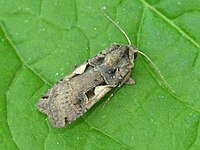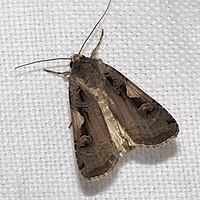Setaceous Hebrew character
| Setaceous Hebrew character | |
|---|---|
 |
|
 |
|
| Scientific classification | |
| Kingdom: | Animalia |
| Phylum: | Arthropoda |
| Class: | Insecta |
| Order: | Lepidoptera |
| Family: | Noctuidae |
| Genus: | Xestia |
| Species: | X. c-nigrum |
| Binomial name | |
|
Xestia c-nigrum (Linnaeus, 1758) |
|
| Synonyms | |
|
|
The setaceous Hebrew character (Xestia c-nigrum) is a moth of the family Noctuidae. It is found in the Palearctic ecozone. It is a common species throughout Europe and North Asia and Central Asia, South Asia, China, Japan and Korea. It is also found in North America, from coast to coast across Canada and the northern United States to western Alaska. It occurs in the Rocky Mountains from Montana to southern Arizona and New Mexico. In the east, it ranges from Maine to North Carolina. It has recently been recorded from Tennessee.
The forewings of this species are reddish-brown with distinctive patterning towards the base; a black mark resembling the Hebrew letter nun (נ) with a pale cream-coloured area adjacent to this mark. The hindwings are cream-coloured.
The wingspan is 35–45 mm. Forewing purplish grey or purplish fuscous with a leaden gloss; costal area at middle ochreous, merged with the bluntly triangular orbicular stigma: cell, a submedian basal blotch, and costal spot before apex purplish black; claviform stigma minute; reniform large, the lower lobe purplish; hindwing ochreous whitish, in female with the termen broadly fuscous.
Lava pink with a broad dark brown subdorsal band. A lateral yellow band with a brown spot on it. Head reddish brown in color.
Two broods are produced each year and the adults are on the wing between May and October. This moth flies at night and is attracted to light and sugar, as well as flowers such as Buddleia, ivy and ragwort.
...
Wikipedia
